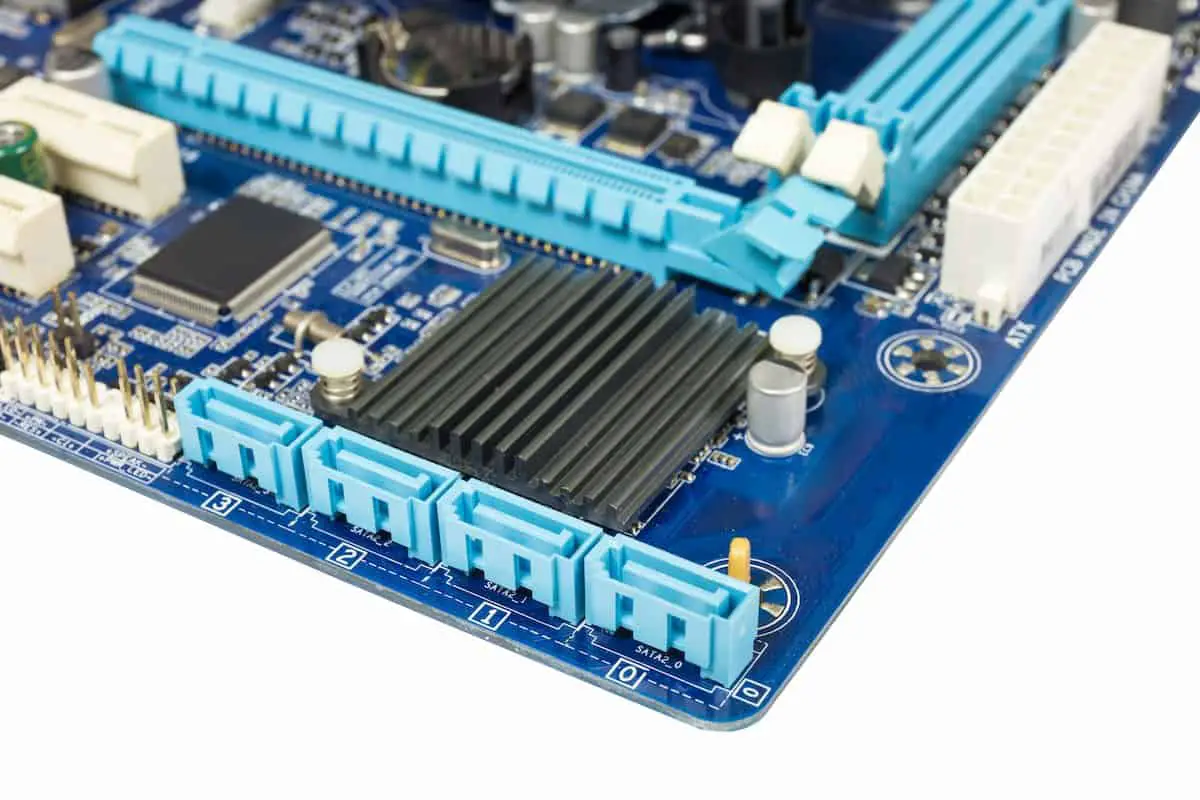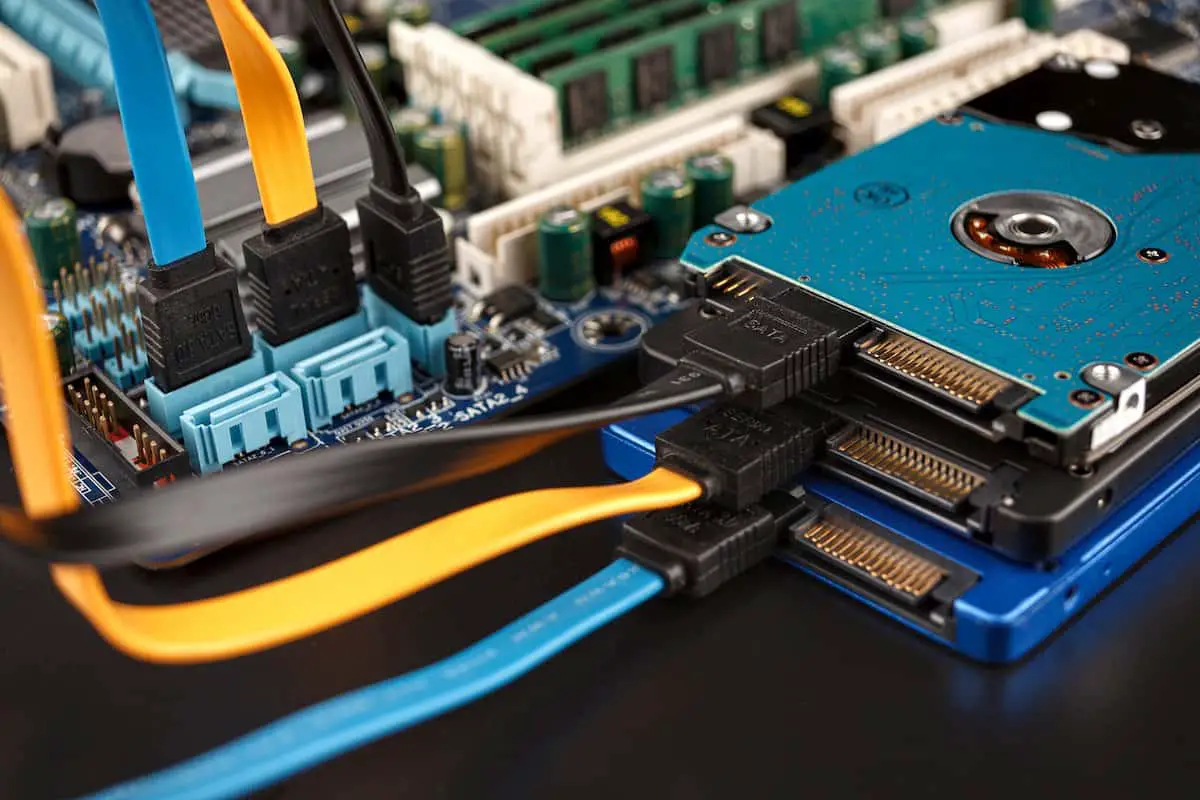When connecting storage devices to your motherboard, you can see that you have different ports that you can use, and you might wonder if there’s any difference between them. Can you use just any SATA port to connect your SSD to the motherboard, or is there a particular order you should follow?
You should use a third-generation SATA (SATA 3) to connect your SSD to your motherboard because it guarantees better performance. SATA 3 can run at 6 Gbps, which is optimal for your SSD, unlike SATA 2 or 1. You can also connect your device using a SATA 2 port, but it won’t perform as well.
If you want to know more about SATA ports and why the way you use them is important, keep reading. I will explain in detail why SATA 3 is the best choice to connect SSDs to your motherboard, how to tell SATA ports apart, and what to do if your SATA ports have issues.
Why Is SATA 3 Best for SSDs?
To connect an internal storage device to your motherboard, you need to use one of the ports located in your motherboard. The number of SATA ports varies in different computers, as does their speed and number of features, depending on what generation they belong to.
SATA 3 is best for an SSD because it matches the drive’s speed, enabling it to work as efficiently as possible. While different storage devices have different SATA ports that they work best with, for a solid-state drive (SSD), a SATA 3 is commonly regarded as the best fit.
Why Does It Matter Which SATA Port I Use?

You should know which SATA ports are suitable for your device. The three SATA generations are different from one another in transfer speed and features, as you’ll see below, so they can affect the performance of some devices.
A SATA 3 port is faster than other generations, with a transfer speed of 6 Gbps, which makes a big difference when you’re dealing with SSDs. Unlike a hard drive, the rate of your SSD depends on the performance of the port it’s connected to, so it makes sense that the optimal choice would be the fastest SATA generation.
Your motherboard may include several ports belonging to different generations. These ports are numbered, usually starting from 0. The order in which you use these ports doesn’t matter as long as they’re the same generation. For instance, if both ports 0 and 1 are third-generation SATA, you can connect your SSD to either one, and it will work the same.
What’s the Difference Between SATA 1, 2, and 3?
As I mentioned above, there are three generations of SATA ports. Each generation has a certain transfer speed and specific features. As you will see, SATA 3 improves several aspects with which the previous generations had issues.
SATA 1
The first generation was introduced in 2003 and was designed to connect a hard drive to the motherboard. Its maximum theoretical speed was 150 Mbps, which was really fast for the time; not a lot of HDDs were able to achieve a speed like that.
SATA 2
However, as technology evolved, SATA 1 started to demonstrate limitations regarding its speed and features, so a second-generation SATA was born a year after the first generation. SATA 2 has a better transfer rate of 300 Mbps and additional improvements in its features and lifespan.
SATA 3
SATA 3, introduced in 2009, has a transfer rate of 600 Mbps. This speed would be more than enough for an HDD, which works perfectly well with a SATA 2. An SSD, on the other hand, needs more than a SATA 2. Basically, SATA 3 was made to connect SSDs, matching their speed. If you want to know more about the differences in booting speed between HDDs and SSDs, check my other article.
Additionally, SATA 3 includes improved features compared to the previous generations, such as more effective power management and better Native Command Queuing, which offers better service for streaming.
As you can see, there are significant differences between the three generations of SATA. While the earlier versions can work well enough with hard disk drives, they can’t match the speed of an SSD. SATA 3 has the necessary speed transfer to help your SSD perform as it should.
What Do SATA Ports Look Like?
If you’re unfamiliar with how a motherboard looks, you may need guidance to locate your SATA ports. It’s pretty easy to identify these ports, even if you don’t see any labels indicating what they are. The SATA ports are relatively small, with particular edges and a distinctive L-shaped connector inside.
These ports are all close to one another and may be different colors if they belong to different generations. If they all belong to the same generation, they will all have the same color.

How To Tell the Difference Between Different Generations of SATA
Now that you know the difference between the three SATA generations in theory and what a port looks like, you need to learn how to tell different generations apart. A typical motherboard can have up to six ports, so how do you know which generation each belongs to?
The first clue you should look for is a label near the port, telling you exactly which generation it belongs to. The label is quite visible and will let you know whether the port is a first, second, or third-generation SATA. This is the case with most motherboards.
If your computer’s motherboard doesn’t have labels, or you can’t see the letters well for some reason, you can look at the color of the ports to determine what generation it belongs to. Naturally, ports of the same color belong to the same generation, but which one? In this case, it might help to learn what colors represent which generation by searching for your motherboard model online.
If you intend to use SATA 3 ports, it may help to keep in mind that in most motherboards with ports of different generations, the first ports are usually SATA 3. If you see no labels or colors but only numbers on the ports, chances are that ports 0 and 1 are third-generation SATA.
What Should I Use if My Computer Doesn’t Have a SATA 3 Port?
Nowadays, motherboards include all SATA generations so that you have options for any device you want to connect. As we’ve established, if you have an SSD that you want to connect to your computer’s motherboard, a SATA 3 port is the ideal choice.
However, you may find some motherboards that don’t include SATA 3 ports, or maybe they do, but there might be issues that have rendered them useless. If you have no SATA 3 port available, can you still connect your SSD to your motherboard?
The short answer is yes; you can use a SATA 2 port to connect your SSD. SATA ports are backward compatible, meaning the older versions can still work with anything compatible with the newest version. So, if your SSD can work with a SATA 3 port, it can also work with the previous generations.
However, since the transfer rate of SATA 3 is higher than the other generations, you won’t get the same performance from your SSD. For instance, if you use a SATA 2 port to connect your SSD, the drive will read and write at half the speed, which you’ll notice. Though not ideal, using a previous-generation SATA can work if, for some reason, you can’t use SATA 3.
What Can I Do if My SSD Is Not Working?
Sometimes, you may experience issues that can be traced back to a problem with the SATA port. For instance, if your SSD or HDD doesn’t appear on your computer or you see the message “No Operating System Found” during startup, your problem is somewhere in the connection between your motherboard and your drive.
To learn the exact cause, you can try these methods:
- Use another SATA port. If you have no issues afterward, it means one particular SATA port is malfunctioning, and you need to avoid it or get it fixed.
- Use another SATA cable. If you try another port and nothing changes, it’s possible that the ports are working as they should, but the SATA cable is the issue. Try another cable and see if the problem is fixed.
- Test the SSD on another computer. If none of the above solutions work, it may mean that the problem is the SSD itself. Connect it to another computer and see if it has any issues. If it does, it means that you should replace your SSD; otherwise, the problem might still be in the motherboard, so it’s better to contact a professional.
Conclusion
SATA ports are specific ports located in your motherboard that are used to connect a storage device to your computer, like an HDD or an SSD. If you’re using an SSD, you should use a third-generation SATA to connect it to the motherboard.
SATA 3 works best for an SSD because it was basically designed to match its speed. With a SATA 3, your SSD can perform at its optimal speed. You can also connect your SSD to a SATA 2 port, which will work but won’t perform as well.
